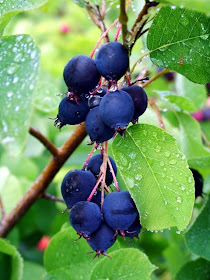The Saskatoon is very similar to the Blueberry.
Common Name: Saskatoon
Other Names: Saskatoon Serviceberry, Pacific Serviceberry, Alder-Leaved Serviceberry/Shadbush, Western Juneberry, Pigeon Berry
Other Names: Saskatoon Serviceberry, Pacific Serviceberry, Alder-Leaved Serviceberry/Shadbush, Western Juneberry, Pigeon Berry
Scientific Name: Amelanchier alnifolia
Family: Rosacaea
Saskatoons ready to eat!
Description:
This medium to very large shrub produces fruit that to many are interchangeable with blueberries. Some think they have a more almond flavor others a hint of apple. I think they just taste like blueberries.
Amelanchier alnifolia
History:
Native to northwestern and north central North America.
Has been gaining popularity over the last decade or so with commercial growers in the north.
Has been gaining popularity over the last decade or so with commercial growers in the north.
Trivia:
Can grow from seal level to over 11,000 feet (3,400 meters).
The city, Saskatoon (in Saskatchewan, Canada) is named after the berry.
The city, Saskatoon (in Saskatchewan, Canada) is named after the berry.
Saskatoon pie!
Or for a healther recipe, just switch Saskatoons for Blueberries...
USING THIS PLANT
Primary Uses:
- Fresh eating.
- Cooked.
- Baked in desserts (pies, tarts, etc.)
- Preserves, jams, jelly.
- Dried.
- Main ingredient or flavor component in wine, beer, and cider.
- Can be used to make pemmican (a Native American preserved food of meat and fruit)
Secondary Uses:
- General insect (especially bees) nectar plant.
- Summer food for wildlife (especially birds).
- Hedges.
- Windbreaks.
- Very tough wood, but small - good for tool handles.
- Has been used to make rope and baskets.
- Ornamental.
- Leaves have been used as a tea substitute, although this genus of plants is known to contain a precursor to cyanide in the leaves. It is very likely that heat destroys this toxin, but caution is advised.
- History of many medicinal uses by Native Americans.
Yield: about 10 lbs (4.5 kg) per plant
Harvesting: Summer (June-July)
Storage: Fresh berries can be stored in a cool dry place for just over a week
The flowers of the Saskatoon are individually and collectively beautiful.
DESIGNING WITH THIS PLANT
USDA Hardiness Zone: 2-7 (depending on the variety)
AHS Heat Zone: No reliable information available
Chill Requirement: There is a strong likelihood, but no reliable information can be found
Plant Type: Medium to Very Large Shrub
Leaf Type: Deciduous
Forest Garden Use: Shrub Layer
Cultivars/Varieties: Many varieties available.
Pollination: Self-Pollinating/Self-Fertile
Flowering: Spring. April-June
Life Span:
Years to Begin Bearing: 2-5 years
Years to Maximum Bearing: 12-15 years
Years of Useful Life: 30-50
Autumn colors make Saskatoon an ornamental plant as well.
PHYSICAL CHARACTERISTICS OF THIS PLANT
Size: 6-15 feet (2-4.5 meters) tall and 6-10 feet (2-3 meters) wide
Roots: Spreading and suckering system of roots.
Growth Rate: Medium
GROWING CONDITIONS FOR THIS PLANT
Light: Prefers full sun
Shade: Tolerates light shade (about 50%)
Moisture: Medium
pH: tolerates a wide range (5.1-8.5)
Special Considerations for Growing: Sunshine is needed for fruit to ripen, so plan and plant accordingly.
Propagation: By seed (needs 5-18 months cold stratification). Seed produce plants true to type (i.e. almost identical to parent plants). Layering (can take 18 months). Division of at least two year old suckers (in late Winter).
Maintenance: Minimal once established. Birds love to eat the fruit, so consider netting.
Concerns: Poisonous – Leaves contain a precursor to cyanide (large amounts can cause death).











Funny, i've just planted an amelanchier Thiessen this morning,
ReplyDeletethanks for the usefull plant profiles
Thanks for the information. Just bought some today.
ReplyDeleteI live in NE WI in USDA Z4b. I relish the juicier Amelanchier fruits like those of the hybrid A. x grandiflora (Apple Serviceberry) and we have 4 native species here, so I decided to try Saskatoons (A. alnifolia). Cvs. such as 'Northline', 'Smokey', 'Thiessen', 'Martin', etc., did not prosper -- my theory is that our daylength here at 45 degrees N latitude is simply too different from that of north central Canada for those cvs. to adapt to growing conditions so unlike those under which they evolved.
ReplyDeletewe have the wild serviceberry in Michigan. the Tre you show is a little more decorative and has bigger berries but ours is still delicious. they can have some very tall parts up to 30 ft or so but have many suckers, side branches ect that are easy to just pull down with a hooked stick or your hands to pick berries. very flexible.
ReplyDeletenice
ReplyDeletenice
نقل عفش بجدة
ReplyDeleteنقل عفش بابها
نقل عفش برابغ
شركات نقل العفش بجازان
نقل عفش بجازان
دينا نقل عفش داخل وخارج مكة
دينا نقل عفش داخل وخارج الرياض
شركات نقل العفش بخميس مشيط
افضل شركة نقل عفش بحائل
شركة تنظيف فلل بجدة
ReplyDeleteشركة تنظيف فلل بالرياض
شركة تنظيف منازل بمكة
https://companymoversinjeddah.wordpress.com
https://allmoversinriyadh.wordpress.com
What’s up, just wanted to mention, I liked
ReplyDeletethis post. It was practical. Keep on posting!
토토
사설토토
Yes i am totally agreed with this article and i just want to say that this article is very nice and vey informative. More blogs please.
ReplyDelete토 토
토토사이트
Amazing article..!! Thank you so much for this informative post. I found some interesting points and lots of information from your blog. Thanks 메이저놀이터
ReplyDeleteThanks for sharing this marvelous post.
ReplyDeleteThankѕ for sharing your thoughts.
ReplyDeleteThanks for your excellent blog and giving great kind of information.
ReplyDeleteAll your hard work is much appreciated.
ReplyDelete
ReplyDeleteGreat Post for Beginner to understand.
our article has answered the question I was wondering about!
ReplyDeletenwebl856fs
ReplyDeletegolden goose outlet
golden goose outlet
golden goose outlet
golden goose outlet
golden goose outlet
supreme outlet
golden goose outlet
golden goose outlet
golden goose outlet
golden goose outlet